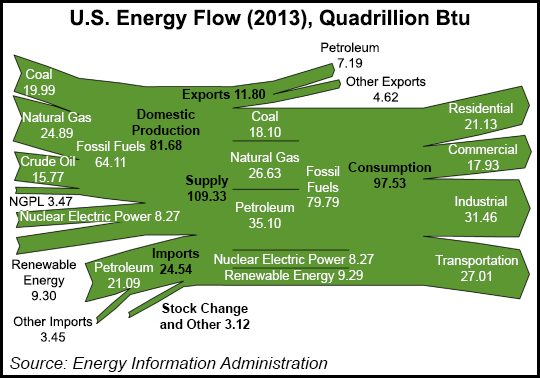NGI Archives | NGI All News Access | NGI The Weekly Gas Market Report
EIA: Domestic Production Met 84% of U.S. Energy Demand in 2013
Total domestic energy production reached about 81.7 quadrillion Btu (quads) in 2013 — enough to meet 84% of the nation’s energy demand — while natural gas, for the third consecutive year, was the largest domestically produced energy resource, according to the U.S. Energy Information Administration (EIA).

In a “Today in Energy” brief released Monday, the EIA said total domestic production was 81.68 quad, of which fossil fuels accounted for 64.11 quad. Natural gas production accounted for 38.8% of total fossil fuel production (24.89 quad), followed by coal at 31.2% (19.99 quad), crude oil at 24.6% (15.77 quad) and hydrocarbon gas liquids at 5.4% (3.47 quad).
Nuclear (8.27 quad) and renewable (9.3 quad) energy sources accounted for the remaining 10.1% and 11.4%, respectively, of total domestic production. The agency said imports of 24.54 quad plus stock change and other of 3.12 quad combined with domestic production to form a supply of 109.33 quad for the year. Exports totaled 11.8 quad in 2013 and were not included in the supply figure.
The EIA said U.S. total energy consumption in 2013 was 97.53 quad, 81.8% of which was met by fossil fuels (79.79 quad). Petroleum accounted for 43.9% of the fossil fuels consumed (35.1 quad), followed by natural gas at 33.4% (26.63 quad) and coal at 22.7% (18.1 quad). Meanwhile, nuclear energy met 8.5% of total consumption (8.27 quad) and renewable energy met 9.5% (9.29 quad).
According to the EIA, about 31.5% of the nation’s energy consumption came from the industrial sector, followed by the transportation (27%), residential (21.1%) and commercial (17.9%) sectors.
“The portion of U.S. energy consumption supplied by domestic production has been increasing since 2005, when it was at its historical low point (69%),” EIA said. “Since 2005, production of domestic resources, particularly natural gas and crude oil, has been increasing as a result of the application of technologies that can develop harder-to-produce resources.
“At the same time, reduced road travel, improved vehicle efficiency, and competition among fuels for electric power generation have limited consumption of petroleum and coal.”
The agency said that the last significant rise in the ratio of domestic production to consumption occurred between 1978 and 1982, when oil consumption declined in response to higher prices and changing policies, and oil production increased with the flow of oil from Alaska’s North Slope. Coal production also increased during that time frame.
© 2024 Natural Gas Intelligence. All rights reserved.
ISSN © 1532-1231 | ISSN © 2577-9877 | ISSN © 1532-1266 |
